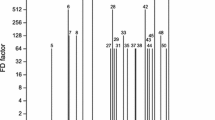Abstract
Nineteen odour-active compounds previously identified with high Flavour Dilution factors in an extract from the peel oil of Pontianak oranges (Citrus nobilis Lour. var. microcarpa Hassk.) were quantified using stable isotope dilution assays (SIDA). For this purpose, four new SIDA were developed, i.e. for the quantification of (E)-2-dodecenal, geraniol, nerol, and 1-phenylethanethiol. The results showed that (R)-limonene, myrcene, and (R)-α-pinene were the predominant compounds present in concentrations between 0.4 and 60 mg/g peel. An aroma recombinate containing the nineteen aroma compounds in the concentrations naturally occurring in the peel oil elicited the overall aroma of the peel oil itself, thus confirming the identification experiments. Furthermore, omission experiments showed that the unique odour quality of the peel is significantly influenced by the resinous, sulphurous-smelling 1-phenylethanethiol, although its concentration was only 38 ng/g peel.







Similar content being viewed by others
Abbreviations
- AEDA:
-
Aroma extract dilution analysis
- CI:
-
Chemical ionization
- EI:
-
Electron impact ionization
- FD-factor:
-
Flavour Dilution-factor
- FID:
-
Flame ionization detector
- HRGC:
-
High resolution gas chromatography
- HRGC-O:
-
High resolution gas chromatography-olfactometry
- HRGC-MS:
-
High resolution gas chromatography-mass spectrometry
- MS:
-
Mass spectrometry
- SAFE:
-
Solvent assisted flavour evaporation
- SHA:
-
Static headspace aroma dilution analysis
- SIDA:
-
Stable isotope dilution assay
- TD-HRGC-MS:
-
Two-dimensional high resolution gas chromatography-mass spectrometry
References
Fischer A, Grab W, Schieberle P (2008) Eur Food Res Technol 227:735–744
Dharmawan J, Kasapis S, Sriramula P, Lear MJ, Curran P (2009) J Agric Food Chem 57:239–244
Engel W, Bahr W, Schieberle P (1999) Eur Food Res Technol 209:237–241
Esterbauer H (1968) Fette Seifen Anstrichmittel 70:1–4
Guth H, Grosch W (1990) Lebensm Wiss u Technol 23:513–522
Guth H, Grosch W (1993) Z Lebensm Unters Forsch 196:22–28
Meier R (2002) Characterisation of changes of key aroma compounds in orange juice and orange juice fractions induced by juice production (in German). PhD thesis, TU Munich
Steinhaus M, Fritsch HT, Schieberle P (2003) J Agric Food Chem 51:7100–7105
Frauendorfer F (2003) Studies on the formation of character impact aroma compounds during roasting of cocoa (in German). PhD thesis, TU Munich
Kerscher R (2000) Animal species related aroma differences of heated meat (in German). PhD thesis, TU Munich
Reiners J (1997) Objective evaluation of the aroma of virgin olive oils of different origins by molecular sensory analysis (in German). PhD thesis, TU Munich
Greger V, Schieberle P (2007) J Agric Food Chem 55:5221–5228
Schieberle P (1995) New developments in methods for analysis of volatile flavour compounds and their precursors. In: Gaonkar AG (ed) Characterisation of food: emerging methods. Elsevier, Amsterdam, pp 403–431
Steinhaus M, Schieberle P (2005) J Agric Food Chem 53:6049–6055
Czerny M, Schieberle P, Christlbauer M, Christlbauer Mo, Fischer A, Granvogl M, Hammer M, Hartl C, Moran-Hernandez N, Schieberle P (2008) Eur Food Res Technol 228:265–273
German Health Organization (Bundesgesundheitsamt) (1993) Official Collection of Analytical Methods according to §35 LMBG (vol I/1), Beuth Verlag, Berlin
Jellinek G (1985) In: Morton ID (ed) Sensory evaluation of food—theory and practice. series in food science and technology. Ellis Horwood, Chichster
Author information
Authors and Affiliations
Corresponding author
Rights and permissions
About this article
Cite this article
Fischer, A., Schieberle, P. Characterisation of the key aroma compounds in the peel oil of Pontianak oranges (Citrus nobilis Lour. var. microcarpa Hassk.) by aroma reconstitution experiments. Eur Food Res Technol 229, 319–328 (2009). https://doi.org/10.1007/s00217-009-1058-4
Received:
Revised:
Accepted:
Published:
Issue Date:
DOI: https://doi.org/10.1007/s00217-009-1058-4




